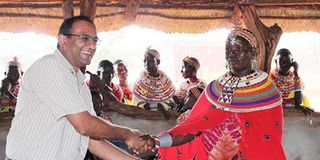Samburu women turn age-old beading craft into cash cow

Mr Vishal Shah, Kalama Community Conservancy beadworks director, rewards Ms Nabiki Leseper from Kalama Women Group after she was named best performer for saving Sh26,220 in her sacco in 2018. Women in Samburu are using necklaces for economic empowerment. PHOTO | GITONGA MARETE | NATION MEDIA GROUP
What you need to know:
- The women are organised into self-help groups and sponsored by the Northern Rangelands Trust.
- Last year, they made Sh11 million from the ornaments and saved Sh1.5 million in a cooperative society.
- Mr Ture Boru, the community’s economic director, said that the women have embraced the project.
Among the Samburu, beaded necklaces are used by morans to “book” girls as young as 12 years for marriage, with the ornaments taking on the odious role as instruments of sexual exploitation.
But women are changing this negative connotation, a bead at a time, by turning the necklaces into tools of economic and social empowerment.
The women from nine community conservancies in Samburu Laikipia, Isiolo and Marsabit counties are organised into self-help groups and sponsored by the Northern Rangelands Trust (NRT).
Last year, they made Sh11 million from the ornaments and saved Sh1.5 million in a cooperative society.

A Samburu woman makes ornaments using beads. Women from nine community conservancies in Samburu Laikipia, Isiolo and Marsabit counties are making necklaces for sale under the sponsorship of Northern Rangelands Trust. PHOTO | FILE | NATION MEDIA GROUP
PROMOTE CONSERVATION
All these are part of an effort to promote environmental conservation and champion alternative livelihoods for young morans through vocational training, so as to curb cattle rustling.
Last Friday, the NRT rewarded the best performers, with the women praising the project as life-changing.
“This project has demonstrated that we are capable of taking care of our families. When we started, we were worried it would bring about conflict in the community but it has instead become a blessing,” said Nabiki Leseper at Kalama Conservancy in Samburu County.
“We have also earned respect in the community and helped promote peace. Through this project, I am able to buy food for my family and take children to school,” said the mother of eight.

Kalama Community Conservancy Economic Director Ture Boru (left) with members of Kalama Women Group. PHOTO | GITONGA MARETE | NATION MEDIA GROUP
RAW MATERIALS
Ms Beatrice Lempaira, the project’s production manager, said NRT provides raw materials, pays the women for their labour and markets the products in the US of America and Australia.
“We work with over 1,000 women who use their skills to earn a living and support conservation efforts,” she said.
Mr Ture Boru, the community’s economic director, said that the women have embraced the project.
“Over the last two years, the women have contributed Sh4 million into the conservancies and the future looks promising,” he said, adding that the groups had borrowed Sh400,000 from the Sacco to set up other businesses as they seek to diversify their incomes.

Crown Princess Mary of Denmark admires beadwork from the Samburu women during a visit to Kenya in 2018. PHOTO | COURTESY
TRAINING INSTITUTE
Mr Boru said there are plans of building a vocational training institute in a new initiative dubbed ‘Ujuzi Manyatani’ (skills in the villages), where morans will be trained in masonry, welding, carpentry and electronics in order to boost their skills.
Beadwork director Vishal Shah said the women have been taught to make belts, wallets and other items suitable for overseas markets.
“They design products that satisfy the tastes of high-value consumers. Initially, they found it difficult to adjust but they have since learnt the art and perfected the products,” Mr Shah said.





